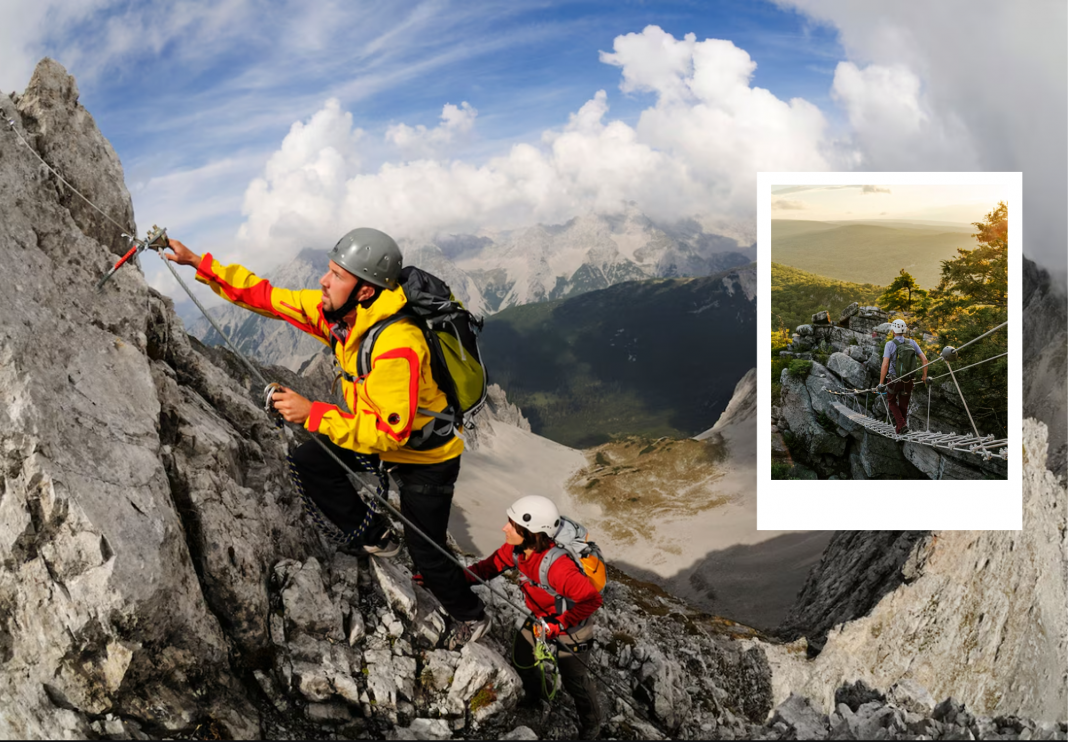Once reserved for alpine peaks and rugged mountain towns, the iron-rung climbing routes known as via ferratas are now rising in some of the most unexpected places: urban parks, abandoned quarries, and even rooftops. As outdoor enthusiasts seek thrilling experiences closer to home, cities across the U.S. are responding with vertical adventures that bring the mountains to the metro.
From wartime escape routes to weekend recreation
Via ferrata—Italian for “iron way”—originated over a century ago in the craggy Dolomite Mountains of northern Italy. These fixed-route climbing paths, equipped with steel cables, rebar rungs, and ladders, were first constructed to aid troops during World War I. Soldiers used them to move safely across dangerous terrain, ferrying equipment and avoiding enemy fire.
After the war, the routes were left intact and gradually repurposed for recreation. What began as a utilitarian tool of warfare evolved into a unique climbing experience—part hiking, part mountaineering. Today, hundreds of via ferratas dot the Italian Alps and have spread across mountainous regions around the world, drawing tourists seeking vertical thrills without the need for technical climbing skills.
A new frontier: urban via ferratas

The newest evolution of the sport brings these lofty experiences closer to home. In recent years, via ferratas have begun to appear within or near U.S. cities—a growing trend that’s reshaping what it means to “get outdoors.” The idea is simple: deliver the adrenaline of alpine climbing with the convenience of a city commute.
“The thrill of climbing a big wall in a remote natural environment is an irreplaceable experience; however, the cost of getting to these locations makes them inaccessible to many,” says Reed Rowley, director of development at Via Ferrata Works. The Colorado-based company was behind the first U.S. urban via ferrata, which opened in Columbus, Ohio, in 2023.
That course—built into the walls of a decommissioned limestone quarry at Quarry Trails Metro Park—has quickly become one of the city’s top outdoor attractions. Just ten minutes from downtown, it offers climbers a 1,040-foot route of rebar ladders, exposed cables, and a 90-foot-long suspension bridge. Park officials report that it books up nearly every weekend it’s open. Rowley sees even greater potential ahead. “When you look at the urban environment as a blank landscape for cabled climbing routes, you begin to see possibilities everywhere,” he says. From parking garages to stadiums, the next generation of via ferratas might not need a mountain at all.
Where to try an urban via ferrata near you
If you’re eager to test your grip and nerve on one of these city-friendly climbs, you don’t need to travel far. Here are four standout via ferratas within two hours of major U.S. cities:
Quarry Trails Metro Park, Ohio

The Columbus via ferrata is not only the first of its kind in an urban setting, but also one of the most accessible. Set in a historic quarry once used to build the Ohio Statehouse, the course challenges climbers with fixed cables, metal ladders, and sky bridges—yet remains friendly for beginners. A guided climb, free with advance registration, includes all gear and takes 90 minutes to two hours to complete. The route is open from March to December, weather permitting.
Mount Blue Sky, Colorado
Just 30 minutes from downtown Denver lies the Mount Blue Sky Via Ferrata, located in Idaho Springs. This mountain-edge course blends vertical climbing with adrenaline-pumping features like zip lines and rappelling. The guided experience lasts around 2.5 hours, with sweeping views of the Arapaho and Pike-San Isabel National Forests along the way. Open from April through October, it’s a more intense course best suited to thrill-seekers ready for heights and harnesses.
Mohonk Mountain House, New York
Less than two hours from Manhattan, this historic Hudson Valley resort recently launched the first via ferrata in New York’s famed Shawangunk Mountains—known locally as “the Gunks.” Built on striking quartz conglomerate cliffs, the Mohonk via ferrata includes over 600 iron rungs, 2,500 feet of cable, and an 80-foot sky ladder that hovers above a lush forest floor. Only guests of Mohonk Mountain House can access the course, which is open year-round, weather depending.

Ausable Chasm Adventure Trail, New York
Known as the “Grand Canyon of the Adirondacks,” Ausable Chasm is home to one of the most scenic via ferratas in the U.S. Just 90 minutes from Burlington, Vermont, the course snakes above the whitewater river through sandstone cliffs, ledges, and six suspension bridges. Open seasonally since 2013, the experience includes a guided climb with gear provided on a first-come, first-served basis each day starting at 9 a.m.
Know before you climb: safety and preparation
While via ferratas are generally accessible to beginners, safety is paramount. Most U.S. courses require a guide, and all provide essential gear: helmets, harnesses, and dual lanyards with carabiners that keep you clipped to the safety cable at all times.
Before you start, you’ll go through a short training on how to navigate the course, use the gear, and clip in and out of cables. Climbing gloves are often recommended to protect your hands from metal surfaces, and sturdy shoes with good traction—like hiking boots or trail runners—are a must.
You don’t need to be an elite athlete, but a reasonable level of fitness and comfort with heights will help. Some courses feature sections hundreds of feet above the ground, so those with a serious fear of heights might want to ease in with a more beginner-friendly course—like Columbus’s Quarry Trails.
The future is vertical
As more Americans seek out adventure close to home, urban via ferratas are poised to grow. They combine accessibility with real excitement, offering the chance to feel like a mountaineer—without leaving city limits. “We’re just getting started,” says Rowley. “The potential is massive.”
Whether you’re an experienced climber or a curious first-timer, these sky-high routes offer a new way to reconnect with nature, test your limits, and see familiar cityscapes from a dramatically different angle. Just don’t look down—unless you’re ready for the view.



